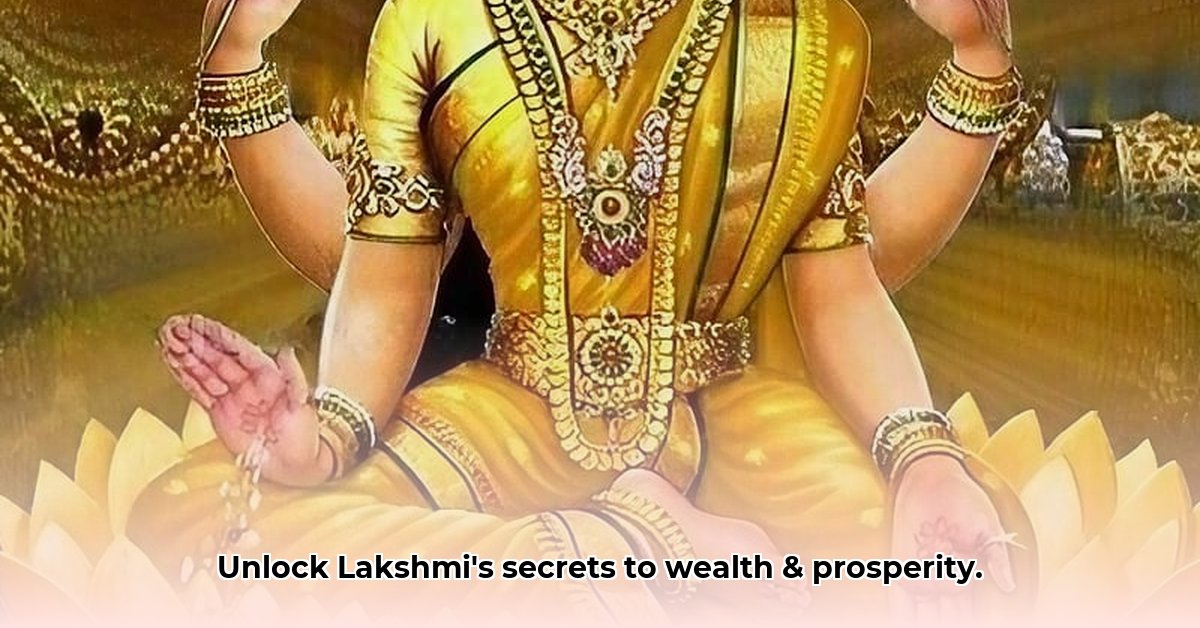
Lakshmi: More Than Just Money, Is it?
Right, so let's chat about Lakshmi, the Hindu goddess often associated with wealth and prosperity. But this isn't just about a bulging bank account, is it? Lakshmi represents a far richer concept – abundance in all its forms. Think of her as a multifaceted gem, each facet reflecting a different aspect of flourishing, both materially and spiritually. Her story stretches back centuries, evolving and adapting alongside Indian culture itself, showcasing the enduring power of faith and its capacity to interpret prosperity in diverse ways. Several key aspects define her enduring appeal and significance.
Lakshmi: A Goddess with Many Forms
Lakshmi isn't a one-dimensional deity. Her image and symbolism have shifted over time and geographically. She embodies not just material wealth, but abundance in all its expressions – spiritual fulfillment, inner peace, and a good life. Often shown seated on a lotus flower – a symbol of purity and growth emerging from seemingly inhospitable surroundings – she’s a potent image of hope and potential. Her four arms represent dharma (righteousness), artha (wealth), kama (pleasure), and moksha (liberation), a beautiful depiction of holistic well-being. This multifaceted nature reflects the complexity of human aspirations and the pursuit of a truly fulfilling life. Did you know that different interpretations of Lakshmi's iconography exist across various regions of India? This adds another layer to her captivating story.
Lakshmi's Birth: A Cosmic Beginning
Lakshmi's origin is as extraordinary as her symbolism. She emerged from the churning of the cosmic ocean (Samudra Manthana), a pivotal event in Hindu mythology where gods and demons collaborated (yes, really!) to extract treasures from the primordial sea. Born from this chaotic yet creative act, Lakshmi embodies the inherent interconnectedness of creation and destruction, highlighting the dynamic nature of existence itself. This mythical birth underscores her position not as merely a goddess, but as a fundamental aspect of the universe’s life-giving energy. The story itself is also a reminder of how ancient narratives contribute to a deeper understanding of Hindu philosophy.
Lakshmi's Visual Evolution: Then and Now
Lakshmi's depictions have evolved through centuries. While earlier representations often featured lions, symbolizing power, later interpretations incorporated elephants, signifying wisdom and good fortune, often shown showering her with water, a symbolic representation of life's abundance. This evolution mirrors the changing cultural understanding of prosperity and the multifaceted nature of wellbeing. This visual adaptability reflects the dynamic nature of religious understanding and shows how artistic representations have played a key role in the widespread acceptance and understanding of Lakshmi.
Diverse Worship Practices Across India
The worship of Lakshmi varies widely across India. In some regions, she's the central figure of Diwali celebrations, while others focus on specific rituals and offerings associated with her eight forms, the Ashta Lakshmi. This diversity showcases the adaptability of faith and the influence of regional cultural practices on religious observance. Such variations emphasize the vibrant and diverse nature of Hinduism and its capacity to adapt to regional nuances. This illustrates the importance of understanding the geographical and cultural contexts in which Lakshmi is worshipped.
Lakshmi's Trans-Religious Appeal
Lakshmi's influence extends beyond Hinduism. Her benevolent nature, representing well-being and prosperity, has resonated with adherents of other faiths, including some Jains and Buddhists. This shared appreciation highlights the universal human desire for a fulfilling life and suggests that religious beliefs often have more common ground than we might imagine, especially in a rich cultural melting pot like India. This cross-religious appeal underscores the fundamental human aspiration for a life of prosperity and well-being.
The Ever-Evolving Story of Lakshmi
Lakshmi's story is a continuous process of understanding and reinterpretation. Her symbolism continues to evolve, reflecting our own ongoing journeys towards abundance – not just material wealth but also inner peace, spiritual growth, and a sense of purpose. This highlights the dynamic and living nature of religious faith and its ability to adapt to the changing needs and interpretations of its followers. It's a story that resonates deeply with our contemporary lives, especially in a world often focused on material success.
Key Aspects of Lakshmi:
- Origin: Born from the churning of the cosmic ocean (Samudra Manthana), symbolizing a primal force of creation and abundance.
- Iconography: Often depicted seated on a lotus flower, with four arms, sometimes with elephants showering her with water, representing purity, growth, dharma, artha, kama, and moksha.
- Festivals: Diwali, a major festival where Lakshmi Puja is central, celebrating wealth, prosperity, light, and good fortune.
- Regional Variations: Diverse rituals and interpretations of Lakshmi's worship and representation reflect the rich tapestry of Indian culture, emphasizing the adaptability of faith and cultural expressions.
Lakshmi's multifaceted story is a testament to the enduring power of faith, the dynamism of cultural interpretation, and the ongoing human pursuit of a life rich in meaning and wellbeing. Her enduring appeal continues to inspire and fascinate, serving as a powerful reminder to strive for abundance in all aspects of our lives.